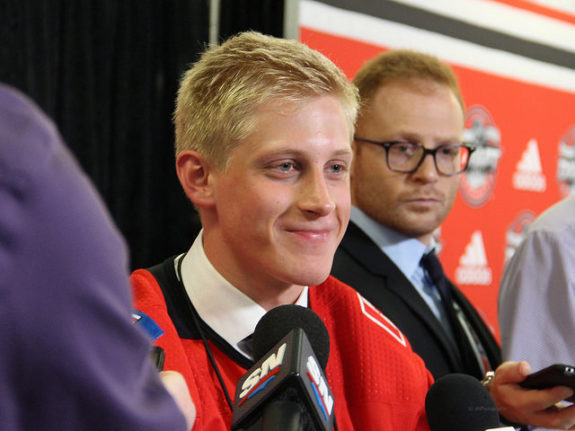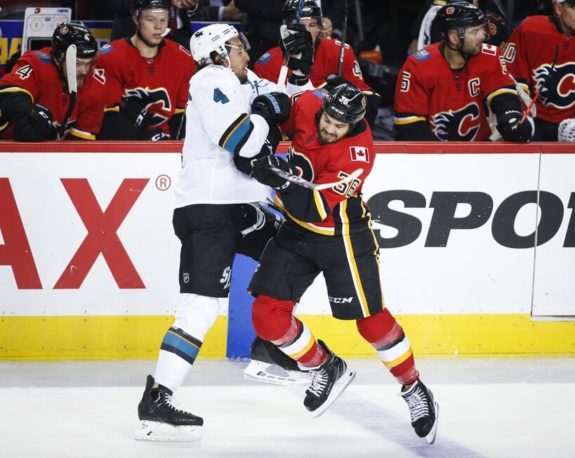The Calgary Flames are breaking all kinds of franchise records this month. And not in a good way.
These stats dropped after another shutout loss to the St Louis Blues: this roster is the first to get shutout in three consecutive road games, the first to allow the first goal in eight consecutive games (and 17 of 25 on the season), and most staggering of all, the first to not hold a lead for a consecutive 400+ minutes of playing time. Keep in mind that the Flames have existed for 40 years.
There could be any number of reasons for this stretch of shockingly bad play. But when your team, mostly unchanged from last season, falls off a cliff despite having coveted talent, those reasons start to sound like excuses. As general manager Brad Treliving said when Glen Gulutzan got fired, “You are what your record says you are.”

Right now, the Flames’ 11-12-3 record actually seems a bit generous in reflecting actual performance.
Any attempt by me to “diagnose” this team would probably just be speculation. I don’t pretend to know what’s wrong, but I do know the Flames are out of excuses. All of the common go-to excuses that get linked to underperforming NHL teams just do not apply to the Flames.
Common Excuses for Failing Teams
It’s Still Early
That may have been true three weeks ago. The clock is ticking on any team outside of the playoff picture, including Calgary.
One of Elliotte Friedman’s favorite stats to share is that 78 percent of teams in a playoff spot at the American Thanksgiving make the playoffs in April. For you Canadian readers out there, American Thanksgiving is this Thursday, Nov. 28.
So not only are the Flames out of excuses, but they are also out of time.
It’s the Schedule’s Fault
The Flames have not had a particularly tough schedule so far. They’ve played four back-to-backs and 15 out of their 26 opponents this season were in the playoffs last year. Considering more than half of NHL teams make the playoffs every year, that’s not out-of-balance by any stretch.
On Nov. 23, they were the only team in the league to have played 26 games. That means that all of the teams ahead of them in the standings also have games-in-hand. Not a good look.
It’s the Injuries
The Flames have sustained some injuries and the losses have no doubt been felt. Austin Czarnik was injured right when he was on a major upswing in terms of production. Travis Hamonic, a major heart-and-soul guy, is out as well. The loss of Sam Bennett hurts (although the team has experienced a noticeable decline in frustrating stick infractions since he left), and TJ Brodie, whatever you think of him, is more valuable than his replacement.
Perhaps the most significant handicap this team has is needing to play most, if not all, of this season without Juuso Valimaki.

These losses, though, have forced some roster creativity and opened opportunities for young players like Dillon Dube. That’s not necessarily a bad thing. Derek Ryan’s line with Dube has probably been the team’s most reliable over the past few games.
Plus, if you look at any league-wide injury reports, the Flames’ situation is not that unique. The Penguins smoked Toronto without Crosby, Letang, or Hornqvist. The Avalanche beat the Flames without Rantanen. The Blues absolutely shelled the Flames without their main sheller, Tarasenko.
None of the Flames’ alleged “top players” are injured right now, that we know of. The point of roster construction is to shelter your team from these inevitable losses.
It’s the Officiating
The Flames lead the league in power-play opportunities against with 87. In a vacuum, that stat could make it seem like the stripes have a vendetta against Calgary. But the Flames are also near the top of the standings in powerplay opportunities for, with 81. As is the case with most teams, the penalty calls for and against Calgary are more or less balanced out.

I’m not discounting the fact that the Flames have had some serious non-calls go against them this year. But if the refs were really out to get you, that gap would be a lot bigger than six powerplay opportunities over 26 games. Some teams have gaps of 17 (Dallas Stars) or 18 (Anaheim Ducks). That’s when you are allowed to complain that the officiating is biased.
It’s Just Bad Luck
As of Nov. 22, The Flames had a PDO at all strengths of .976. PDO, which is calculated as shooting percentage plus save percentage, is sometimes considered as a gauge of the team’s “luck.” A PDO of 1.000 is considered exactly average, anything less is unlucky. By this metric, only a few teams have had less puck luck than the Flames— the Columbus Blue Jackets, Detroit Red Wings, New Jersey Devils, and Los Angeles Kings.
Many expect the Flames to gradually return to the mean. They probably will. But the following tweet by Flames reporter Darren Haynes, who covers the team in The Canadian Press and The Athletic, is insightful:
The Flames’ PDO won’t improve or return to the mean just by virtue of playing more games and increasing sample size. The team needs to improve its shot placement (hitting the net) and shot locations (where on the ice they are shooting from).
They are near the top of the league in Shot Attempts, yet at the very bottom for goals per game. That says, among other things, that they are missing the net or hitting the goalie’s logo. A lot.
This is more than just bounces going the wrong way.
Time to Turn a Corner
The Flames are not oblivious to their own issues. They held a players-only meeting on Nov. 22, the same day that Brad Treliving took media questions about the team’s performance, choosing to shoulder much of the blame himself.
After barely escaping with two points against the Flyers in the shootout, the Flames still have not held a lead in regulation for several games. Hopefully, the extra-time win will help them turn a corner.
Calgary has a bad habit of making the playoffs one season and then missing them the next. Positive goal differential one season, and then negative the next. If this two-year cycle is going to end in 2019-20, the Flames need to come together and figure this out soon. There’s no more excuses and no more time.